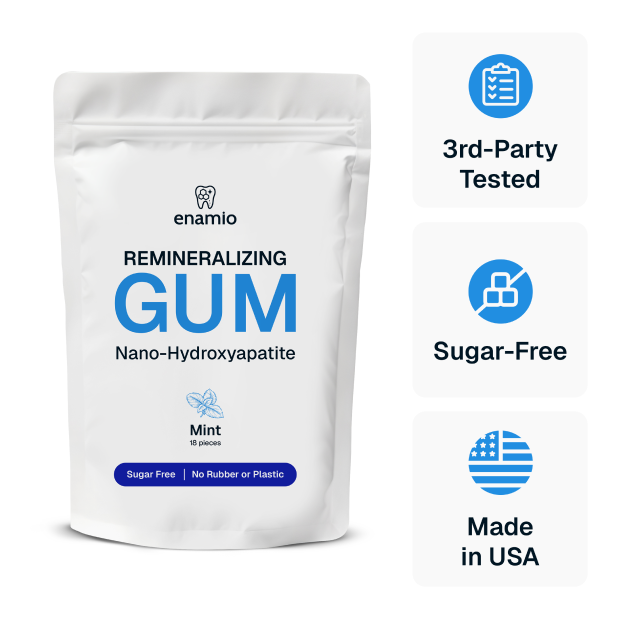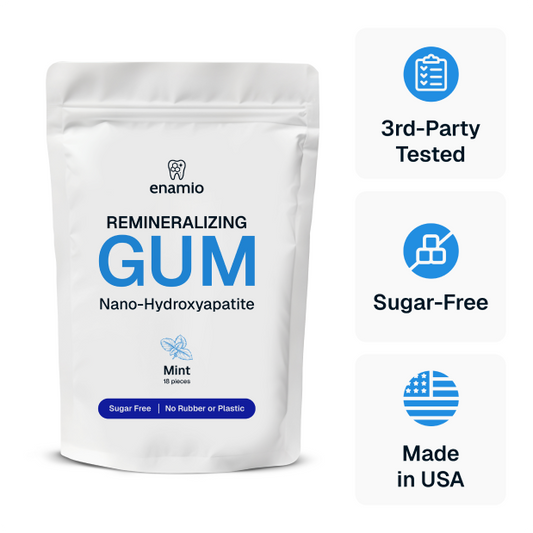Nano Hydroxyapatite Gum 2025: Evidence & Protocols | Enamio
Share
Nano Hydroxyapatite Gum 2025: Evidence, Protocols & Buyer’s Playbook
What you’ll get: how nano hydroxyapatite gum supports enamel remineralization, the role of saliva/pH, what a best-in-class formula looks like (n-HA, CaGP, arginine, xylitol, zinc, matcha), safety, and step-by-step usage protocols—plus a transparent comparison with competitors.

- Nano hydroxyapatite gum supplies enamel-matching minerals precisely when post-meal acids lower pH.
- Look for a stack: n-HA (~20 nm) + calcium glycerophosphate (CaGP) + arginine (ADS) + xylitol ± zinc & catechins.
- Sugar-free gum increases saliva and helps plaque pH recover; n-HA supports early (non-cavitated) lesion repair.
- Enamio uses 20-nm n-HA and the highest n-HA concentration of any gum we’re aware of—without plastic or synthetic rubber.
- The hook: why timing beats intent
- The problem: enamel under acid pressure
- The science: saliva, pH, biomimetic minerals
- How Enamio’s nano hydroxyapatite gum works
- After-meal timeline (what actually happens)
- Protocols: how to use
- Buyer’s checklist: what to demand
- Enamio vs competitors
- Use cases & cautions
- FAQs
- References
The hook: why timing beats intent
Nano hydroxyapatite gum is about catching the window that most routines miss: the 30–60 minutes after eating or drinking. That’s when plaque pH dips below the “critical” zone for enamel (≈5.5), and dissolved minerals can either be lost—or redeposited if you supply the right inputs and saliva flow. This is where gum’s mechanical chewing, saliva stimulation, and biomimetic minerals align to help refill early, non-cavitated enamel defects while pH rebounds.
The problem: enamel under constant acid pressure
Every fermentable snack or sip—soda, fruit juice, sticky carbs—feeds acidogenic bacteria and pushes pH down. Over time, repeated demineralization can show up as white-spot lesions, sensitivity, and eventually cavitation. Globally, oral diseases affect roughly 3.5+ billion people, and in the U.S., the majority of adults have experienced dental caries at some point in life. Early intervention matters because initial lesions can be stabilized or reversed with consistent remineralization support and behavior change.
The science: saliva, pH, and biomimetic minerals
Chewing sugar-free gum increases salivary flow and buffering, helping plaque pH recover after meals. This isn’t theoretical: studies using sugar-free and bicarbonate gums show meaningful pH rebounds and improved salivary metrics after chewing. Meanwhile, nano-hydroxyapatite (n-HA)—chemically similar to enamel’s carbonated hydroxyapatite—can integrate at the surface to support early lesion remineralization and reduce dentin hypersensitivity in clinical and in-vitro models. Particle size and morphology matter: rod-like particles in the ~20–80 nm range resemble natural enamel crystallites, encouraging biomimetic repair.
Complementary actives strengthen the effect: arginine (via the arginine deiminase system, ADS) is converted by beneficial plaque organisms into alkaline by-products that nudge pH upward; xylitol is non-fermentable and can reduce cariogenic bacteria while boosting saliva; calcium glycerophosphate (CaGP) adds readily available calcium/phosphate; zinc helps neutralize volatile sulfur compounds (breath) and exhibits antimicrobial activity; green tea catechins (e.g., matcha) can inhibit S. mutans biofilms in vitro and clinical settings.
How Enamio’s nano hydroxyapatite gum works (and why details matter)
- 20-nm biomimetic n-HA: small enough for surface micro-defects, engineered to mirror enamel’s crystal habit.
- CaGP + magnesium citrate: maintains a supersaturated state for redeposition during pH recovery.
- Arginine bicarbonate (ADS): supports a less acidogenic biofilm and faster neutralization.
- Xylitol (USP) + monk fruit: non-fermentable sweetness and palatability without sugar.
- Matcha extract + zinc gluconate: biofilm modulation and breath support.
- Plastic-free chicle + candelilla: a cleaner base—no plastic or synthetic rubber—to encourage daily use.
Result: a stacked approach that delivers minerals when you need them most, helps pH rebound, and supports a healthier biofilm—without adding sugars or plastics.
Try Enamio Remineralizing Gum
Highest n-HA concentration of any gum we’ve found, 20-nm biomimetic particles, plus CaGP, arginine, xylitol, zinc, and matcha—in a plastic-free chicle base.
Add to CartAfter-meal timeline (what actually happens)
| Time | Event | What to do |
|---|---|---|
| 0–5 min | Plaque pH dips below ~5.5; enamel starts losing mineral. | Sip water; avoid brushing immediately on acid-softened enamel. |
| 5–10 min | Pellicle reforms; saliva buffering ramps up. | Start chewing nano hydroxyapatite gum. |
| 10–20 min | Saliva flow aids pH recovery; n-HA and Ca/PO4 redeposit. | Chew 10–20 minutes; stay hydrated. |
| 20–60 min | Net remineralization window—especially for early lesions. | Delay acidic drinks briefly; resume normal routine after. |
Protocols: how to use nano hydroxyapatite gum
- Chew after meals for 10–20 minutes (2–3×/day).
- Drink water alongside; avoid immediately following with acidic beverages.
- Stay consistent for 8–12 weeks; evaluate sensitivity and smoothness.
- Orthodontics/aligners: increase to brief sessions after snacks.
- Frequent coffee/soda: prioritize post-beverage chewing.
- Dry mouth: consider extra hydration and medical guidance.
Buyer’s checklist: what to demand in an n-HA gum
- Particle disclosure: ~20–80 nm, rod-like morphology aligned with enamel crystallites.
- Support ions: CaGP ± magnesium to maintain supersaturation.
- Biofilm pH support: arginine (ADS) + non-fermentable xylitol.
- Breath & antioxidant layer: zinc + green tea catechins.
- Base quality: plastic-free (e.g., chicle), comfortable chew.
- Transparent label: avoid unnecessary colorants; clear ingredient intent.
Enamio vs other nano hydroxyapatite gums
| Feature | Enamio | Underbrush Gum | Nathan & Sons |
|---|---|---|---|
| n-HA particle spec | ~20 nm, biomimetic, rod-like | Present; public size often not stated | Present; public size varies/limited |
| n-HA concentration | Highest we’ve found in gum (no % disclosed) | Not disclosed | Not disclosed |
| Support actives | CaGP, Mg, Arginine (ADS), Xylitol, Matcha, Zinc | Varies; typically xylitol + minerals | Varies; limited public detail |
| Gum base | Plastic-free chicle + candelilla | Tree sap mixes (may include chicle) | Varies by product |
Notes: competitor specs pulled from public pages at time of writing; verify latest labels and websites.
Use cases & cautions
- Orthodontics/aligners: post-meal chewing helps counter enamel challenges during treatment.
- Coffee/tea/wine routine: pair with water rinses and post-beverage chewing to reduce “stain hang-up.”
- Dry mouth (xerostomia): saliva support is helpful; consult your dentist/physician for underlying causes.
- GI sensitivity to polyols: xylitol can cause GI upset in high amounts; adjust frequency if needed.
- Allergies/flavors: check mint oil content; choose flavors you tolerate.
- What Is the Best Remineralizing Gum? A Science-First Buyer’s Guide
- Chewing Mineral for Gum Health: Deep-Dive Guide
- Can You Rebuild Tooth Enamel? Myth vs Reality
- How to Reverse Cavities? The Complete Guide
- What Gum Helps Remineralize Teeth?
- Why Enamio’s n-HA Works Better Than Toothpaste
- Does Remineralizing Gum Actually Work?
- Does Xylitol Gum Remineralize Teeth?
- How to Use Remineralizing Gum (2025)
- Complete Guide to Remineralizing Gum
End of article exclusive
Ready to try what you just learned? Enamio features 20-nm nano-hydroxyapatite at the highest gum concentration we’ve seen—plus CaGP, arginine, xylitol, zinc, and matcha in a plastic-free base.
Buy Enamio Remineralizing GumFAQ
Does nano hydroxyapatite gum actually rebuild enamel?
It helps remineralize early (non-cavitated) lesions by supplying enamel-matching crystals during salivary pH recovery. Studies report improvements in surface microhardness and mineral density. It does not fill a full cavity (that’s restorative dentistry).
n-HA vs fluoride—what does the evidence say?
Multiple controlled trials show n-HA performs similarly to standard fluoride for early-lesion remineralization and dentin hypersensitivity relief, with excellent biocompatibility. Mechanisms differ: n-HA is biomimetic crystal repair while fluoride favors a hardened fluorapatite surface layer.
Is nano hydroxyapatite safe in daily gum?
Hydroxyapatite is biomimetic and considered safe in oral products within specified particle specs and concentrations (recent EU scientific opinions detail this). Gum is chewed and expectorated; incidental ingestion is low risk for healthy individuals.
What makes a high-quality n-HA gum formula?
- Biomimetic particle size (~20–80 nm) and rod-like morphology
- Supportive ions (CaGP, Mg) and pH buffers (arginine)
- Non-fermentable sweeteners (xylitol)
- Breath science (zinc), gentle antioxidants (matcha)
- Plastic-free base that encourages daily adherence
How should I use n-HA gum for best results?
Chew after meals for 10–20 minutes, 2–3× daily. Stay hydrated and keep the habit for at least 8–12 weeks before evaluating changes.
Can I combine n-HA gum with fluoride toothpaste?
Yes—many clinicians pair them. n-HA helps refill micro-defects; fluoride contributes to a more acid-resistant surface. Avoid brushing immediately after acids; let pH rebound first.
References
- World Health Organization: Oral Health Fact Sheet
- NIDCR/NIH: Dental Caries in U.S. Adults (statistics)
- BDJ Team: Oral benefits of sugar-free gum
- Bicarbonate sugar-free gum raises salivary & plaque pH
- Hydroxyapatite in oral care—review (particle size, efficacy)
- 20-nm n-HA remineralizes initial enamel lesions (in vitro)
- Meta-analysis: HAP effective for dentin hypersensitivity
- Arginine deiminase system: biofilm pH modulation
- Calcium glycerophosphate: anti-caries properties (model)
- CaGP mouthrinse: remineralization support (2023)
- Zinc ions and volatile sulfur compounds
- Green tea catechins inhibit S. mutans biofilms
- EU SCCS safety opinion on hydroxyapatite (nano)
Enamio Editorial Team partners with clinicians and researchers to translate peer-reviewed science into practical, daily oral care. Content is medically reviewed for accuracy and updated as new evidence emerges.
Educational content only; not medical advice. Always consult your dental professional.

